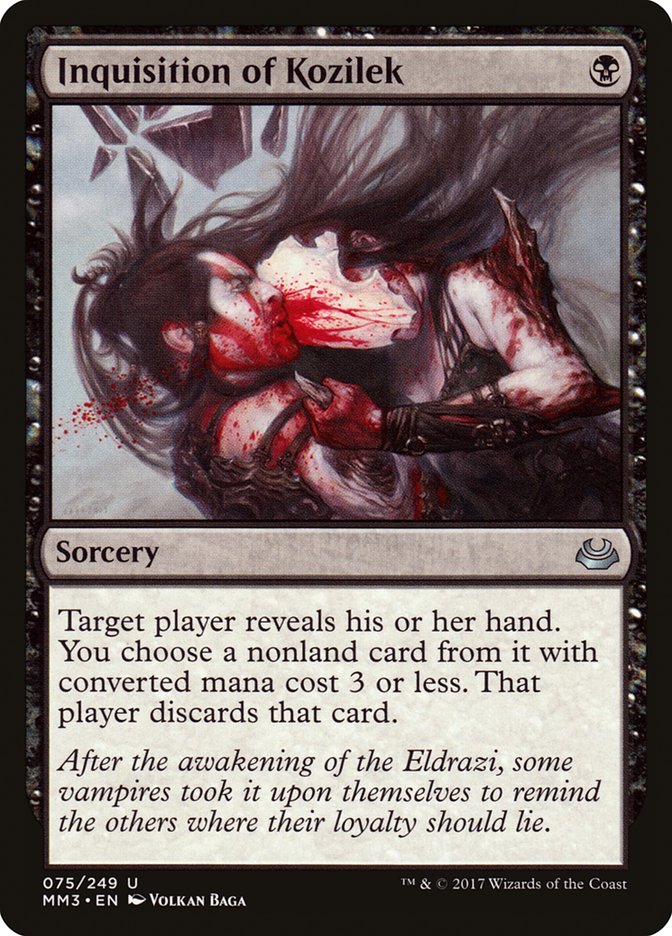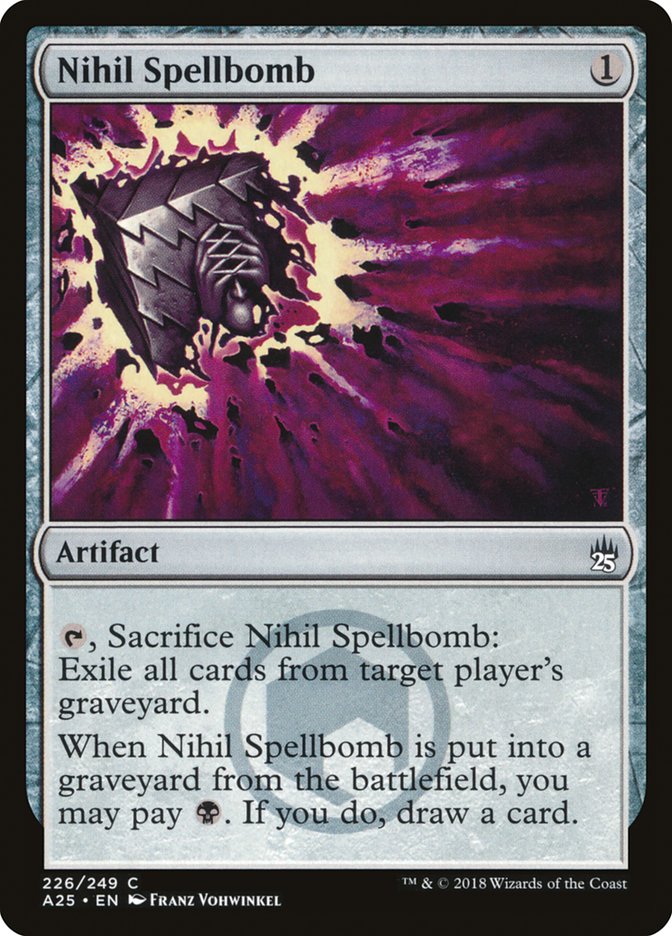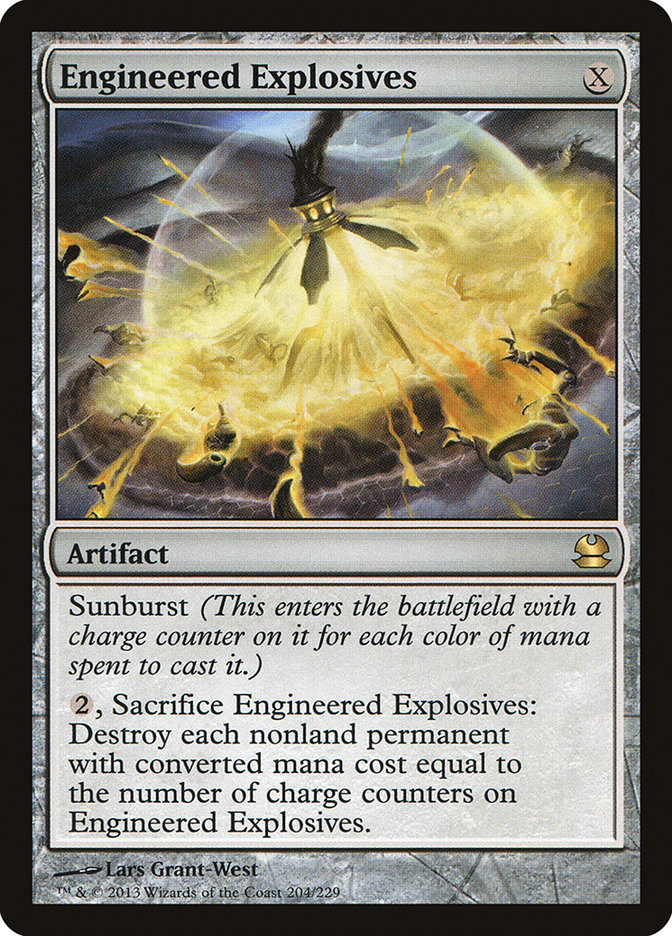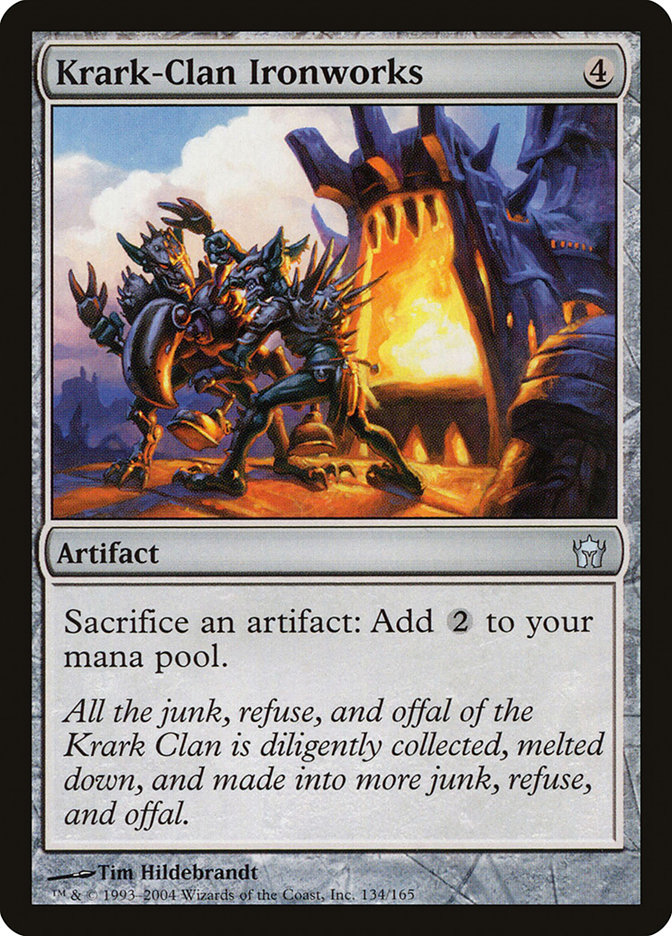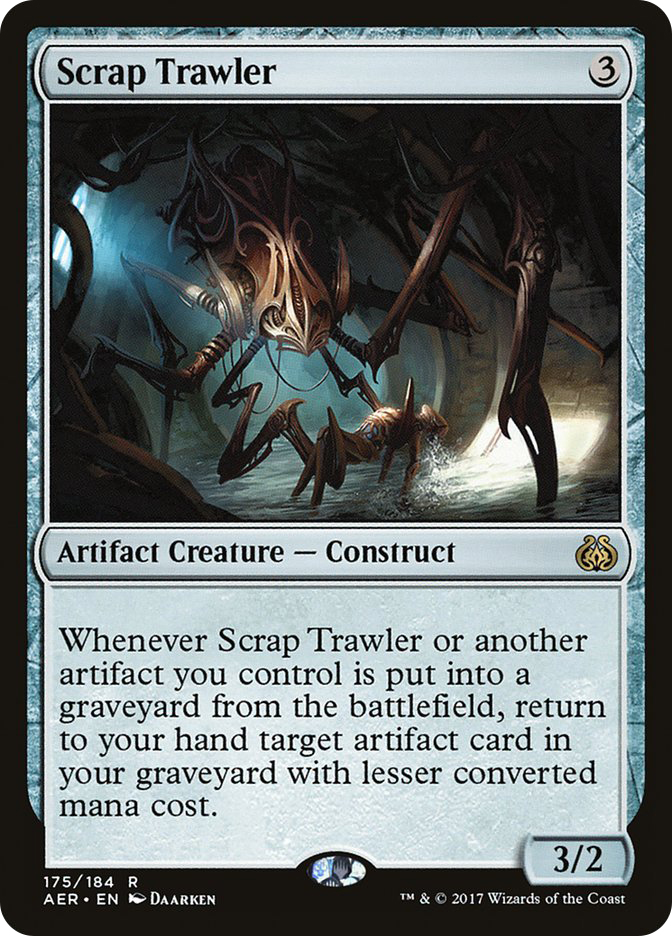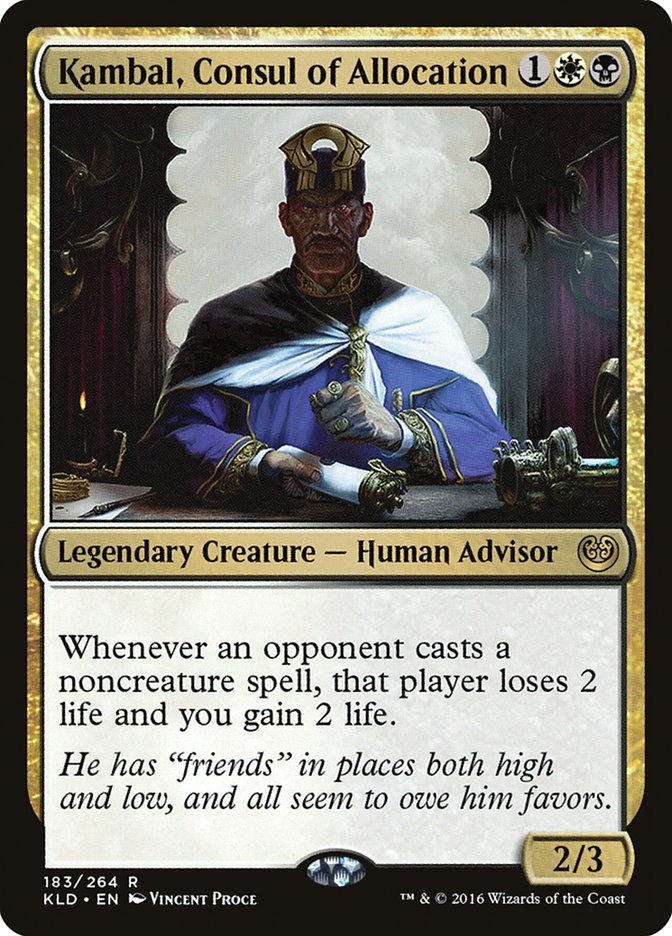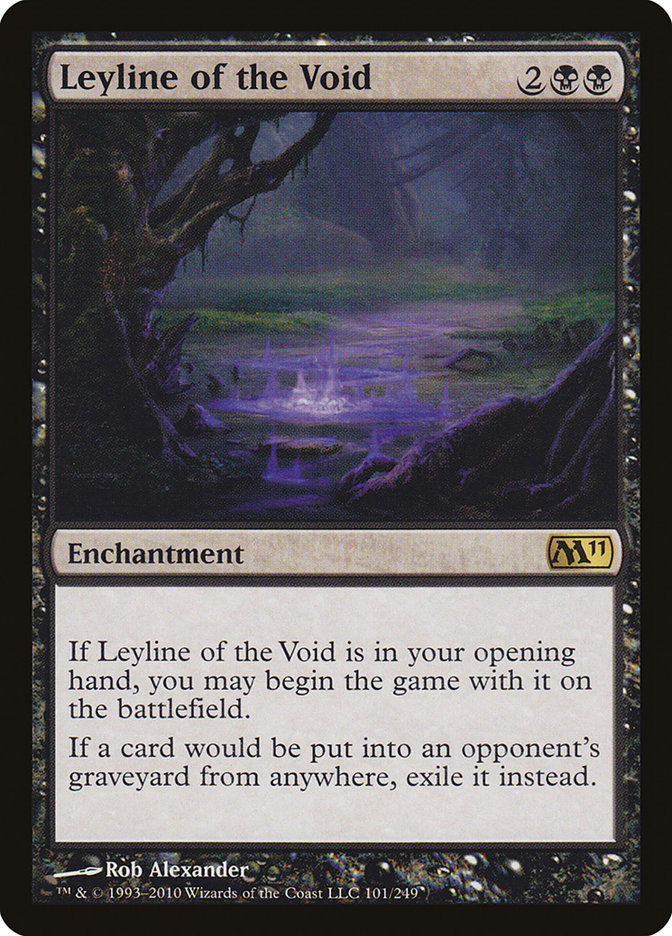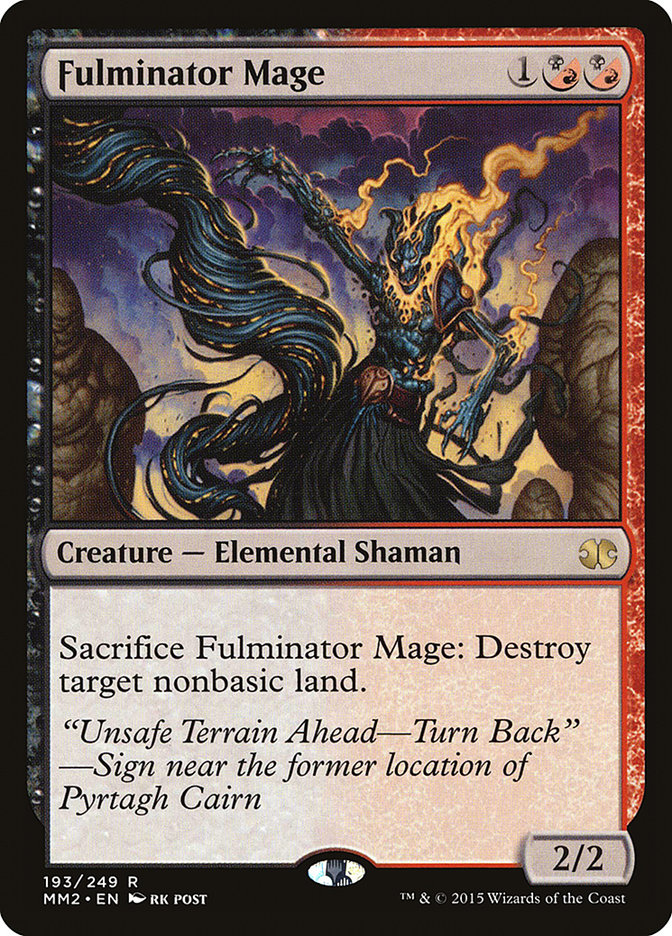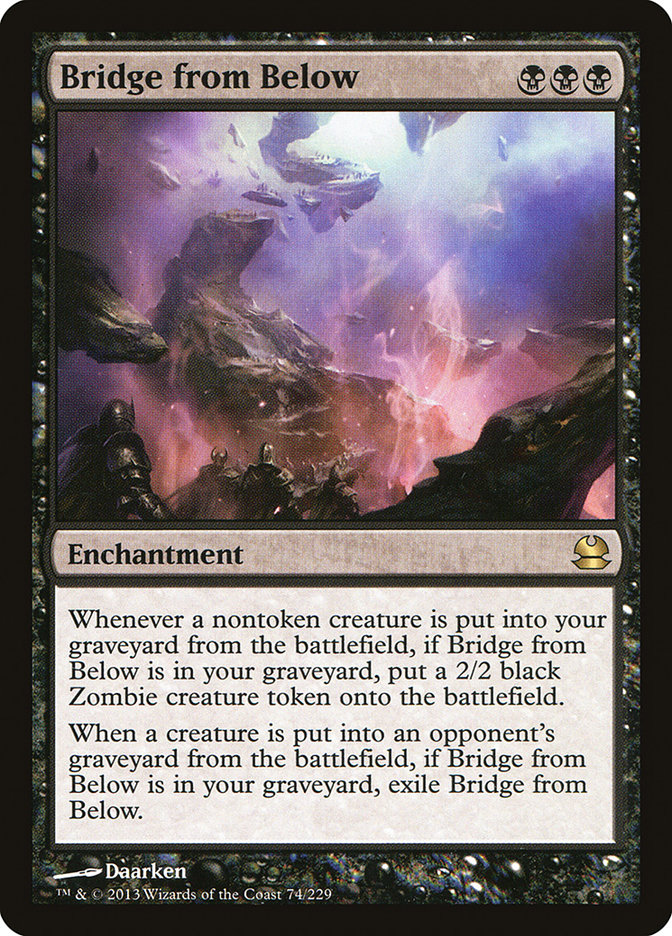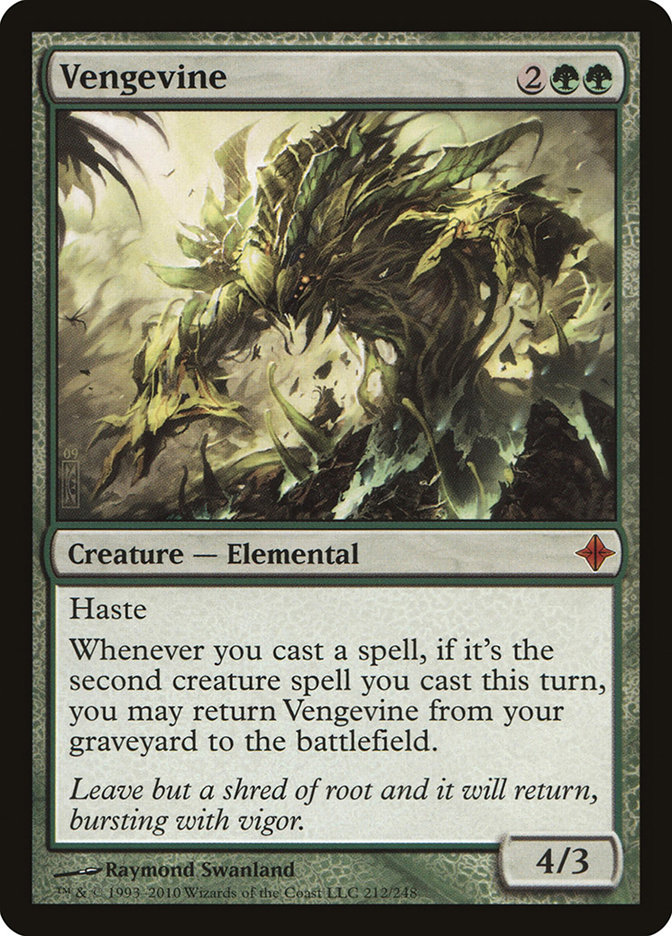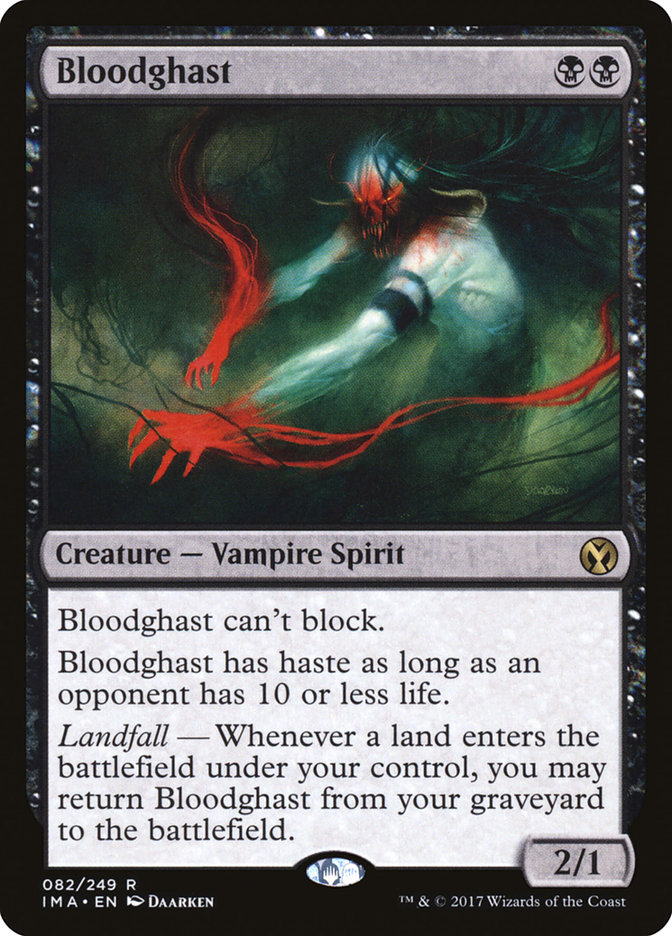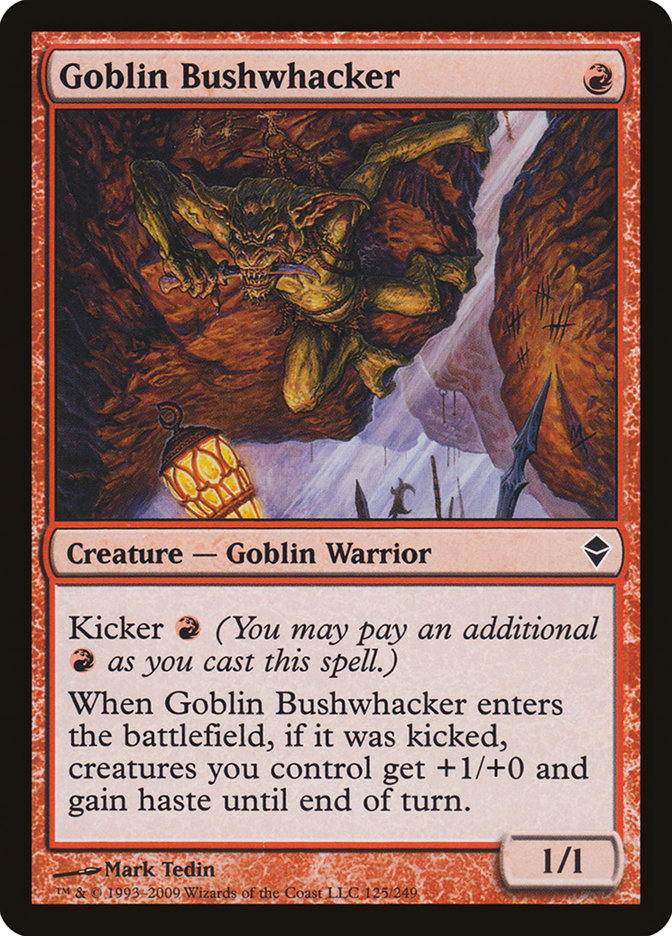The Modern landscape has changed a lot recently. Aside from a couple months
of uncertainty after the unbanning of Bloodbraid Elf and Jace, the Mind
Sculptor, Modern has looked more or less the same since the printing of
Unclaimed Territory and the rise of Humans. Sure, the format has shifted
around as decks gain and lose popularity on the wings of the metagame, but
it has been the same decks rising and falling in an endless cycle, with few
new movers entering the scene.
Until now.
Creatures (6)
Lands (18)
Spells (36)
- 4 Krark-Clan Ironworks
- 2 Pyrite Spellbomb
- 3 Chromatic Sphere
- 4 Mind Stone
- 3 Engineered Explosives
- 4 Terrarion
- 4 Chromatic Star
- 4 Ancient Stirrings
- 4 Mox Opal
- 4 Ichor Wellspring
Sideboard

Ironworks, largely thanks to the heroics of Matt Nass, has been slowly
making its way into Modern’s top tier for awhile now. At this point, it’s
hard to argue against the deck being a real contender in Modern. It made
the finals of Pro Tour 25th Anniversary in the hands of Ben Stark and was
the third most popular deck at that event with over 10% of the field on it.
The extremely high complexity of the deck probably worked to slow the
deck’s rise, but it looks like we’ve now reached the point where players
are willing to put in the work to unlock the enticingly high win percentage
that Ironworks offers.
Creatures (35)
- 4 Greater Gargadon
- 4 Bloodghast
- 4 Goblin Bushwhacker
- 4 Vengevine
- 4 Gravecrawler
- 3 Hangarback Walker
- 4 Insolent Neonate
- 4 Walking Ballista
- 4 Stitcher's Supplier
Lands (17)
Spells (8)
Sideboard

If you were to come up to me and tell me that B/R Vengevine was a very
explosive deck, I would agree with you, but I wouldn’t know precisely what
you meant. You see, it’s difficult to decide which makes the deck more
explosive: it’s ability to produce upwards of six power and toughness on
the first turn of the game or the speed at which it transitioned from a
fringe Magic Online deck to a respectable deck selection made by 6% of the
Pro Tour 25th Anniversary field, the sixth most popular deck choice.
Luckily, we don’t really need to decide which is the more noteworthy
accomplishment, as they both point towards the same truth: this deck is the
real deal and it’s here to stay.
These new decks are all well and good, but not that appealing to those of
us looking to stick with the fair side of Magic. But even if we have no
desire to play these decks, we still have to put in the work to make sure
we understand them. How else will we know what to Thoughtseize?
Going with the tried-and-true strategy of always Thoughtseizing the
namesake card of the deck works well for Ironworks, but you really
shouldn’t try that against B/R Vengevine. Jokes aside, the whole draw to
midrange as a strategy in Modern is that you’re never dead to a
particular matchup. As a dedicated Jund mage, Tron is basically the bane of
my existence, but even when my opponent leads on Urza’s Mine, I still know
that I have somewhere around a 30% chance to win. The flip side of this
matchup resiliency is that to claim your full win rate, you must know
exactly what you’re supposed to do in every matchup. Little missteps will
cost you big, and it’s hard not to make a misstep against new decks. And
so, let’s dive in to how to best combat this new breed of unfair decks.
Similarities to a Thoughtseize Mage
But first, a brief discussion of why it makes sense to consider these two
decks at the same time. Yes, they’re both new entries into Modern entering
the limelight at the same time, but that’s not enough to get me to want to
pair them. After all, they are fundamentally different decks. One is a
set-up combo deck that does very little to affect the battlefield until the
turn it kills you, the other is an explosive graveyard-fueled battlefield
presence deck that seeks to win through the combat step, often over the
course of multiple turns. They’re both susceptible to graveyard hate, but
that’s the only obvious link between them.
The first similarity that has me interested in pairing them is that both
decks are quite good against discard spells. Inquisition of Kozilek and
Thoughtseize are black midrange’s first line of defense against unfair
decks in Modern, so it’s never good when unfair decks resilient to discard
pop up. Don’t get me wrong, Inquisition and Thoughtseize still have a role
to play in these matchups, they aren’t just awful. But they’re much worse
then they are against Storm and other classical unfair Modern decks, and
that’s something we have to respect.
B/R Vengevine is good against discard because the entire purpose of the
deck is to get the key cards into the graveyard. Taking a Bridge From Below
with an Inquisition doesn’t help you in the slightest, outside of fringe
scenarios where you take it and then immediately kill one of your own
creatures to exile it, but that doesn’t come up very often. No, your
discard is mostly reduced to attacking the enablers in this matchup, but
they play so many enablers that this is quite the Sisyphean task.
Redundancy is also the main reason why discard is anemic against Ironworks.
Krark-Clan Ironworks and Scrap Trawler matter a lot, Engineered Explosives
can matter a little, and everything else virtually doesn’t matter. Worse,
everything else helps dig for those cards. A very large percentage of the
Ironworks deck is cantrip artifacts, and discard has always underperformed
against decks relying on vast quantities of cantrips. You have to
Thoughtseize at very specific times to nab a card that matters, and it’s
always just a matter of time until they find a replacement.
The other important similarity between these two decks is that they’re both
uniquely resilient to hate, albeit for very different reasons. There was a
game shown on camera last weekend at Pro Tour 25th Anniversary between Bant
Spirits and B/R Vengevine where the Spirits player had Turn 2 Rest in Peace
on the play.
And lost.
The B/R Vengevine player got a Bridge From Below into the graveyard on the
only turn they would have such a thing and promptly traded in a bunch of
zero mana artifact creatures in the hand for 2/2 Zombies on the
battlefield. With a little help from a Goblin Bushwhacker, they were enough
to get the job done. A Turn 2 Rest In Peace on the play was just
too slow.
That game was certainly a tad atypical, but the fact that it’s possible demonstrates what I’m trying to get across: B/R Vengevine
can get under your hate cards and win despite the fragility of their
gameplan. This isn’t to say that you shouldn’t play hate cards against B/R
Vengevine, to the contrary, you need them, it’s to say that you effectively
get to play less of them.
Wait, what was that? The idea here is that the way we value cards affects
how many we get to play, virtually speaking. If you have a three-of in your
sideboard that by itself wins a matchup 90% of the time, you’re going to
get to play it more often than a three-of in your sideboard that needs help
to win the matchup. This is because you get to keep weaker hands that have
the better sideboard card, hands that you wouldn’t otherwise keep, but you
can’t do that with the weaker card.
In that Bant Spirits VS B/R Vengevine match, the Bant Spirits player must
have valued that Rest In Peace in their opening hand very highly. The rest
of their hand didn’t do much, and they died quickly to three Zombie tokens.
That’s the point: hate cards alone won’t be good enough against B/R
Vengevine, the rest of your draw still needs to function in short order.
The same logic applies to Ironworks, but for very different reasons.
Ironworks doesn’t get under your hate cards, but it’s uniquely good at
beating them. The fact that the deck just naturally wants zero-mana
artifacts means it gets to play with Engineered Explosives, and the deck is
designed to find the specific artifacts it needs as soon as possible. This
adds up to meaning that trying to beat Ironworks with permanent-based hate
is a huge headache.
The takeaway from this concept of the devaluation of hate cards against
these new unfair decks is simple: you need to play more of them. Against
less robust combo decks, the high EV strategy is to play a few pieces of
powerful hate and aggressively look for them, but these two decks are very
good at punishing that plan. But since you’re a midrange deck, you do still
have to interact with them, which means you need to register a higher
quantity of hate cards.
Modern being what it is, you can’t really afford to dedicate much more of
your sideboard real estate to these two decks. So instead of playing a few
really powerful hate cards, you end up playing a lot of marginally
effective pieces of interaction. The kinds of cards that are good, not
great, in these matchups and still good in other places. You need to up the
raw number of sideboard cards you have for these decks, which in Modern
tends to mean decreasing the power level of each of them to ensure your
bases are still covered.
VS Ironworks
The first thing to understand about Ironworks is that you’re overthinking
it. The deck is very complicated and filled with niche interactions, but if
you’re not playing the deck, very little of that complexity matters to you.
Don’t be intimidated by the complexity. Forget everything you think you
knew about the steps of casting a spell and the weird rules quirks of
generating more mana than you need to pay for a spell. Your knowledge of
those things will not be tested. Here’s what does matter:
From your perspective as the opponent, Ironworks functions as a two-card
combo deck. Your goal is to end the game before they manage to get
Krark-Clan Ironworks and Scrap Trawler on the battlefield simultaneously.
Yes, there’s much more to it than that, and there are times when
understanding the intricacies will benefit you, but as a base-level
shortcut, treating it as a two-card combo will serve you well.
Generally, two-card combo decks are good for black midrange. The card
Thoughtseize is at its best against these kinds of decks, but we’ve already
discussed why this isn’t the case against Ironworks. The thing to
understand, to really internalize, about Ironworks is that if you give them
enough time, they will find it. You can Thoughtseize them every turn of the
game, if you aren’t attacking with a Tarmogoyf simultaneously, they will
eventually win the game. You need to put them under pressure.
This is important to talk about, because it’s the easiest step. Value
Tarmogoyf higher than Thoughtseize in your opening hand. Mulligan hands
that don’t put Ironworks under pressure quickly, no matter how disruptive
they are. Time is not your friend in this matchup. No matter how good a job
you do disrupting them, no matter how tricky you get with your interaction,
they will win the game unless you win it first.
With that distasteful ‘aggression is paramount’ admonition out of the way,
let’s dive in to the fun stuff: how to use our interaction to stop them
from comboing for as many turns as possible. As discussed, they have two
cards that really matter: Krark-Clan Ironworks and Scrap Trawler. Because
we play so much removal, they will typically hold Scrap Trawler until after
Ironworks comes down. This means four mana is the critical amount that we
want to Thoughtseize prior to.
In a perfect world, we would Thoughtseize them on turn 3 to nab Krark-Clan
Ironworks. Unfortunately, there’s a complication:
The presence of Mox Opal in their deck means that they can jump from two to
four mana on turn 3 and potentially combo you right then and there if their
hand is particularly strong. If the Mox Opal is on the battlefield, it’s
immediately apparent that you should Thoughtseize ahead of schedule. If
not, I tend to err towards not respecting the potential Opal. Every turn
you get to delay your Thoughtseize is a turn of cantrips you get to see the
end result of, and that value is enough for me to risk the Turn 3 kill. I
also am ideally deploying a threat on turn 2, further shifting the
calculus.
Since Inquisition of Kozilek cannot take Krark-Clan Ironworks, you’re less
incentivized to hold it as long. You’re still somewhat incentivized to do
so, as Scrap Trawler tends to sit in their hand as long as Ironworks does,
and that’s the best card for Inquisition to hit. Still, your Inquisitions
will often just take Ancient Stirrings or a cheap artifact and I’m willing
to cast them earlier than Thoughtseize if it makes sense with my curve.
As a simple rule of thumb, here’s my loose hierarchy of Thoughtseize takes,
from best discard to worst:
Krark-Clan Ironworks, Scrap Trawler, Ancient Stirrings, Ichor Wellspring,
Myr Retriever, Chromatic Star, Terrarion, Chromatic Sphere. Engineered
Explosives is highly variable depending on the state of the battlefield,
but sometimes is a very important take. Mox Opal is sometimes a valuable
take if they are mana light, but in general the graveyard is a perfect spot
for it in their eyes anyway. After sideboard your discard spells get better
as they let you take Nature’s Claim and Engineered Explosives to protect
your hate cards, as well as combo with early graveyard hate like Surgical
Extraction.
There’s not a lot to this. Your removal spells are important pieces of
interaction in that they can kill Scrap Trawler. You tend to want to do
this as early as possible, and when you get to the point in the game where
they can combo you, you’ll want to make sure you leave mana up. Ideally,
you’ll be pairing your Lightning Bolt with one of these:
The ideal sequence with Nihil Spellbomb is to Lightning Bolt their Scrap
Trawler then get their graveyard with the Scrap Trawler trigger on the
stack. Ditto for Surgical Extraction, although it’s important to note that
you’re likely better off using Surgical on the Trawler itself, not whatever
the target of the trigger was.
If you have Nihil Spellbomb or Surgical Extraction without a removal spell,
don’t expect things to go well for you. With a Scrap Trawler on the
battlefield, the Ironworks player can just respond by sacrificing another
artifact and claiming whatever was important in their graveyard. They will
make sure that the graveyard you exile is the one that is optimal for them.
Without a Bolt to go along with them, these cards aren’t prizes. Get
whatever value you can from them and don’t expect too much.
Your permanents that shut down their ability to combo are pretty simple to
play: get them on the table as soon as possible. There’s very little reason
to ever wait; trying to get fancy and play them the turn before they go to
combo so they have to spend a turn using Engineered Explosives on your hate
card before they combo rarely works out. Leyline of the Void and Rest in
Peace especially just do such a good job shutting down the engines of their
deck that every turn you manage with them in play is for the best.
What’s interesting about these cards is what to do with duplicates. Kambal,
Consul of Allocation is legendary so that’s not a concern, but when you
have a Leyline of the Void on the battlefield and one in hand, do you play
the second to play around Nature’s Claim or hold it to play around
Engineered Explosives? Unfortunately, there’s not a clear answer here: do
what seems right based on context and whatever reads you might have, erring
towards playing around Engineered Explosives because that’s the one that
the deck’s engines are capable of finding.
This frequently encountered dilemma does have a cool ramification: when
possible, diversify the converted mana cost of the permanent hate cards you
play against Ironworks. Two copies of Leyline of the Void is much easier
for Ironworks to beat than a copy of Leyline and a copy of Rest in Peace or
Kambal.
Last card before we move off Ironworks: I like Fulminator Mage quite a bit
in this matchup. Fulminator isn’t great, you don’t value it highly, but
it’s exactly what I think you need against these hate-resistant unfair
decks: a card that interacts with them, even if weakly. Despite the intense
amount of mana that Krark-Clan Ironworks can generate, they need four mana
the normal way to get off the ground, so to speak. Fulminator can slow that
down and that’s important.
Your highest priority targets with Fulminator Mage are Inventors’ Fair and
Buried Ruin. Keeping these cards off the table can make your Thoughtseizes
actually matter, as it greatly reduces their ability to find additional
copies of their key cards. It can be tempting to take their only green
source to turn off any Ancient Stirrings they may find, but between
Chromatic Sphere, Chromatic Star, Terrarion, and Mox Opal, you’re better
off just taking the value lands. When they need colored mana, they’ll have
it.
VS B/R Vengevine
From the perspective of a black midrange deck, the B/R Vengevine matchup is
an exercise in battlefield control. Yes, they’re an unfair deck, but they
do win the game in a fair way: the combat step. This means that every
creature you deploy to the battlefield is an enormous asset. They only have
one path to your life total, and your creatures stand in the way.
This means that B/R Vengevine is the rare unfair matchup where I’m not going to sit here and preach about how important it is to be
aggressive. You do need to end the game eventually, but not until you are
firmly in control of the battlefield. Your goal is to shut down the
powerful unfair things they’re doing, eliminate their resources, and
eventually take control of the game. Let’s begin.
These cards are much more straightforward in this matchup. You can’t touch
their cards that actually matter, so you have to take the enablers. In
almost every circumstance, it’s better to take creatures than
non-creatures. Faithless Looting digs deeper and fills the graveyard
fuller, but Insolent Neonate makes Zombie tokens and brings back Vengevine.
That’s far more important. Stitcher’s Supplier, Insolent Neonate, Goblin
Bushwhacker, and Faithless Looting are the four big cards you’re looking to
take with your discard effects, roughly in that order of priority though it
changes a lot based on the contents of their hand and what’s in their
graveyard already. Greater Gargodon and/or Viscera Seer are also valuable
takes in some spots.
Using your removal on their creatures works the same as it always has, and
it should be pretty apparent when that’s something you need to be doing.
More interesting is your ability to use removal on your own creatures in
this matchup to exile copies of Bridge From Below from their graveyard.
Bridge From Below is by far the most powerful thing they can do in this
matchup and the easiest way for them to beat you, and keeping them in check
is an important thing to keep an eye out for.
Let’s talk for a second about the different unfair things they have access
to. The two main sources of power that the deck has access to are Bridge
From Below and Vengevine, with Bloodghast and Gravecrawler providing lesser
amounts of graveyard-fueled power. Bridge From Below is by far the most
important to us as black midrange players. Typically, we can handle a
Vengevine. A 4/3 isn’t a super troubling body, and if we kill it a few
times they will eventually run out of creatures to keep bringing it back.
Bridge from Below is a whole different story.
What this means is you should rarely ever use any of your graveyard hate
after sideboard if they don’t have a Bridge in the graveyard. You can deal
with Vengevine in other ways. Narrow your focus to Bridge From Below, and
only consider using Nihil Spellbomb on graveyards without Bridge if your
opponent’s resources are very low and you think you can close out the game
before they refill.
For this reason, I’ll often bring Fulminator Mage in after sideboard in
this matchup. The card is very unimpressive and quite slow, but it’s a turn
3 way to get rid of the Bridges in their graveyard without losing any
creatures that are actually contributing to my battlefield. Again, breadth
of interaction is what we’re going for, not depth.
You always need to be thinking about this card when playing against B/R
Vengevine. Its ability to add a bunch of damage out of nowhere should
always be at the forefront of your mind and needs to be respected. It can
be tempting to try and turn the corner when the battlefield looks stable,
but if that puts you in a tight spot against a potential Goblin
Bushwhacker, you should probably think again.
This matchup is bad for you as a black midrange player, but it’s rise as
the premier graveyard deck is good for us. Dredge is too slow for the
format, but a much worse matchup for us as we can’t ever hope to out grind
Dredge in a long game. Against B/R Vengevine, if you can survive the
initial onslaught and interact with the Bridge From Below, you can very
easily manage a win.



